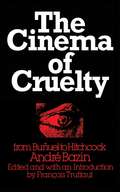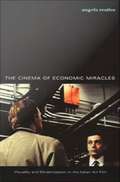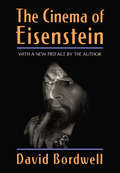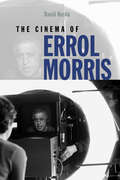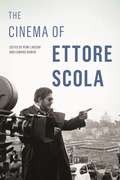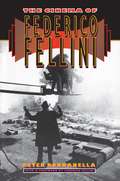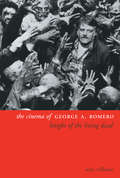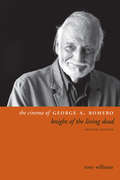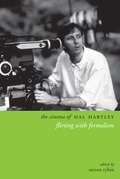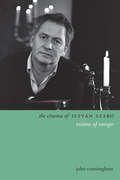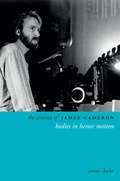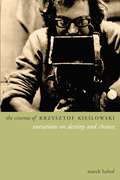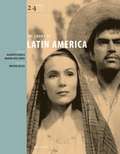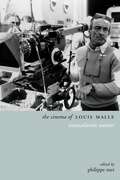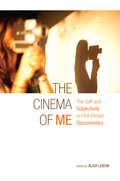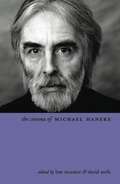- Table View
- List View
The Cinema of Cruelty: From Buñuel to Hitchcock
by André Bazin François TruffautPerhaps the single most important voice of cinema in the twentieth century, André Bazin profoundly influenced the development of the scholarship that we know now as film criticism. Bazin has acutely analyzed the cinematic values of our time, extending to his international audiences "the impact of art for the understanding and discrimination of his readers."The depth and logic of his commentary has elevated film criticism to new heights. The reputation of André Bazin continues to grow as his writings are published and studied by filmmakers and filmgoers alike. Often referred to as the Edmund Wilson of film, Bazin was more than a critic. "He made me see certain aspects of my work that I was unaware of," said Luis Buñuel. "He was our conscience," wrote Jean Renoir. "He was a logician in action," echoed François Truffaut.In The Cinema of Cruelty, François Truffaut, one of France's most celebrated and versatile filmmakers, has collected Bazin's writings on six film "greats": Erich von Stroheim, Carl Dreyer, Preston Sturges, Luis Buñuel, Alfred Hitchcock, and Akira Kurosawa. The result is a major collection of film criticism.
The Cinema of Economic Miracles: Visuality and Modernization in the Italian Art Film
by Angelo RestivoThe Italian art cinema of the 1960s is known worldwide for its brilliance and vitality. Yet rarely has this cinema been considered in relation to the profound economic and cultural changes that transformed Italy during the sixties--described as the "economic miracle. " Angelo Restivo argues for a completely new understanding of that cinema as a negotiation between a national aesthetic tradition of realism and a nascent postmodern image culture. Restivo studies numerous films of the period, focusing mainly on the works of Pier Paolo Pasolini and Michelangelo Antonioni. He finds that these auteurs' films reworked the neorealist aesthetic developed in the 1940s and 1950s, explored issues brought to the fore by the subsequent consumer boom, and presaged developments central to both critical theory and the visual arts in the 1980s and 1990s. Drawing on the theories of Lacan, Zizek, Benjamin, Foucault, Jameson, and Deleuze, he shines new light on such films as Pasolini's Accattone and Teorema, and Antonioni's Red Desert and Blow-Up. Restivo's model for understanding the relationship of the 1960s Italian art film to its cultural contexts also has implications that extend to the developing national cinemas of countries such as Brazil and Taiwan. The Cinema of Economic Miracles will interest scholars and students in all areas of film studies, especially those studying theories of the image, national cinema theory, and Italian cinema, and to those engaged in poststructuralist theory, philosophy, and comparative literature.
The Cinema of Eisenstein
by David BordwellThe Cinema of Eisenstein is David Bordwell's comprehensive analysis of the films of Sergei Eisenstein, arguably the key figure in the entire history of film. The director of such classics as Potemkin, Ivan the Terrible, October, Strike, and Alexander Nevsky, Eisenstein theorized montage, presented Soviet realism to the world, and mastered the concept of film epic. Comprehensive, authoritative, and illustrated throughout, this classic work deserves to be on the shelf of every serious student of cinema.
The Cinema of Errol Morris (Wesleyan Film)
by David ReshaThe Cinema of Errol Morris offers close analyses of the director's films--from box office successes like The Thin Blue Line and The Fog of War to Morris's early works like Vernon, Florida and controversial films like Standard Operating Procedure. Film scholar David Resha's reappraisal of Morris's films allows us to rethink the traditional distinction between stylistically conservative documentaries, which are closely invested in evidence and reality, and stylistically adventurous films, which artfully call to question such claims of nonfiction and truth. According to Resha, Errol Morris does not fit neatly in this division of the documentary tradition. Rather, his experiments with documentary conventions constitute another way to investigate reality--in particular, to examine the ways in which his subjects understand, and misunderstand, themselves and the world around them. Seen within the nonfiction tradition, an Errol Morris documentary is a flexible form of lively, engaging storytelling and shrewd, cutting, in-depth reportage.
The Cinema of Ettore Scola (Contemporary Approaches to Film and Media Series)
by Luca Zamparini Millicent Marcus Pierre Sorlin Fabrizio Cilento Edward Bowen Rémi Lanzoni Mariapia Comand Francesca Borrione Christian Uva Brian Tholl Emiliano Guaraldo Federica Colleoni Marina Vargau Nicoletta Marini-Maio Dario Marcucci Gian Piero BrunettaThe Cinema of Ettore Scola offers contemporary perspectives on Ettore Scola (1931–2016), one of the premier filmmakers of Italian cinema. Scola was a crucial figure in postwar Italy as a screenwriter of comedies in the 1950s and 1960s who later became one of the country’s most beloved directors in the 1970s and 1980s with his bittersweet comedies and dramas on history, politics, and social customs. While Scola has received extensive attention from scholars based in Italy and France, Rémi Lanzoni and Edward Bowen’s edited volume is the first English-language book on Scola’s cinematographic career. The volume (containing fourteen chapters) is organized in four parts, the first two of which focus both on Scola’s contributions to Comedy Italian Style—as a screenwriter and director—and his commentaries on the history of Italy, Rome, and the film industry. The second half of the book is divided into sections on Scola’s relationship to and use of place, politics, and legacy. Mariapia Comand’s chapter begins the volume with an exploration of the development of Scola’s narrative methods by examining his early work as an illustrator, ghostwriter, and screenwriter. Later, Brian Tholl approaches one of Scola’s best-known and most frequently studied films, Una giornata particolare, from a less-explored perspective, namely its commentary on surveillance and internal exile, or confino, during the fascist period. At the close of the volume is a broad-sweeping tribute to and reflection on Scola’s filmmaking by Gian Piero Brunetta, a leading historian of Italian cinema who developed a close relationship with Scola over the years, who reveals the varied narrative strategies linked to food that the director utilized for character development and social commentary. The Cinema of Ettore Scola makes Scola accessible to English-reading audiences and helps readers better understand his film style, the major themes of his work, and the representations of twentieth-century Italian history in his films.
The Cinema of Federico Fellini
by Peter BondanellaThis major artistic biography of Federico Fellini shows how his exuberant imagination has been shaped by popular culture, literature, and his encounter with the ideas of C. G. Jung, especially Jungian dream interpretation. Covering Fellini's entire career, the book links his mature accomplishments to his first employment as a cartoonist, gagman, and sketch-artist during the Fascist era and his development as a leading neo-realist scriptwriter. Peter Bondanella thoroughly explores key Fellinian themes to reveal the director's growth not only as an artistic master of the visual image but also as an astute interpreter of culture and politics. Throughout the book Bondanella draws on a new archive of several dozen manuscripts, obtained from Fellini and his scriptwriters. These previously unexamined documents allow a comprehensive treatment of Fellini's important part in the rise of Italian neorealism and the even more decisive role that he played in the evolution of Italian cinema beyond neorealism in the 1950s. By probing Fellini's recurring themes, Bondanella reinterprets the visual qualities of the director's body of work--and also discloses in the films a critical and intellectual vitality often hidden by Fellini's reputation as a storyteller and entertainer. After two chapters on Fellini's precinematic career, the book covers all the films to date in analytical chapters arranged by topic: Fellini and his growth beyond his neorealist apprenticeship, dreams and metacinema, literature and cinema, Fellini and politics, Fellini and the image of women, and La voce della luna and the cinema of poetry.
The Cinema of George A. Romero
by Tony WilliamsThe Cinema of George A. Romero: Knight of the Living Dead is the first in-depth study in English of the career of this foremost auteur working at the margins of the Hollywood mainstream in the horror genre. In placing Romero's oeuvre in the context of literary naturalism, the book explores the relevance of the director's films within American cultural traditions and thus explains the potency of such work beyond 'splatter movie' models. The author explores the roots of naturalism in the work of Emile Zola and traces this through to the EC Comics of the 1950s and on to the work of Stephen King. In so doing, the book illuminates the importance of seminal Romero texts such as Night of the Living Dead (1968), Creepshow (1982), Monkey Shines (1988), The Dark Half (1992). This study also includes full coverage of Romero's latest feature, Bruiser (2000), as well as his screenplays and teleplays.
The Cinema of George A. Romero
by Tony WilliamsIn placing Romero's oeuvre in the context of literary naturalism, the book explores the relevance of the director's films within American cultural traditions and thus explains the potency of such work beyond 'splatter movie' models. The author explores the roots of naturalism in the work of Emile Zola and traces this through to the EC Comics of the 1950s and on to the work of Stephen King. In so doing, the book illuminates the importance of seminal Romero texts such as Night of the Living Dead (1968), Creepshow (1982), Monkey Shines (1988), The Dark Half (1992). This study also includes full coverage of Romero's latest feature, Bruiser (2000), as well as his screenplays and teleplays.
The Cinema of George A. Romero: Knight of the Living Dead (Directors' Cuts)
by Tony WilliamsThe Cinema of George A. Romero: Knight of the Living Dead is the first in-depth study in English of the career of this foremost auteur working at the margins of the Hollywood mainstream in the horror genre. In placing Romero's oeuvre in the context of literary naturalism, the book explores the relevance of the director's films within American cultural traditions and thus explains the potency of such work beyond 'splatter movie' models. The author explores the roots of naturalism in the work of Emile Zola and traces this through to the EC Comics of the 1950s and on to the work of Stephen King. In so doing, the book illuminates the importance of seminal Romero texts such as Night of the Living Dead (1968), Creepshow (1982), Monkey Shines (1988), The Dark Half (1992). This study also includes full coverage of Romero's latest feature, Bruiser (2000), as well as his screenplays and teleplays.
The Cinema of George A. Romero: Knight of the Living Dead, Second Edition (Directors' Cuts)
by Tony WilliamsIn this comprehensive portrait of horror's definitive director, Tony Williams ties George A. Romero's films to the development of literary naturalism and American culture, expanding the artist's creative footprint beyond his mastery of the "splatter movie" genre. Williams locates Romero's influences in the work of Emile Zola, the Entertainment Comics of the 1950s, and the novels of Stephen King, revealing the interdisciplinary depth of his seminal films Night of the Living Dead (1968), Creepshow (1982), Monkey Shines (1988), and The Dark Half (1992). For this second edition, Williams reads Romero's Bruiser (2000) against his more recent Land of the Dead (2005) and takes a fresh look at Diary of the Dead (2007) and Survival of the Dead (2009), two overlooked films that feature Romero's greatest achievements yet.
The Cinema of Hal Hartley: Flirting with Formalism (Directors' Cuts)
by Steven RybinOver the course of nearly thirty years, Hal Hartley has cultivated a reputation as one of America's most steadfastly independent film directors. From his breakthrough films – The Unbelievable Truth (1989), Trust (1990), and Simple Men (1992) – to his recently completed 'Henry Fool' trilogy, Hartley has honed a rigorous, deadpan, and instantly recognizable film style informed by both European modernism and playful revisions of Classical Hollywood genres. Featuring new essays on this important director and his films, this collection explores Hartley's work from a variety of aesthetic, cultural, and economic contexts, while also looking closely at his collaborations with actors, the contexts of his authorial reputation, his reworking of the romantic comedy and other genres, and the shifting economics of his filmmaking.This book, up-to-date through Hartley's latest film, Ned Rifle (2014), includes new scholarship on the director's early work as well as reflections on his cinema in connection with new theories and approaches to independent filmmaking. Covering the entire trajectory of his career, including both his features and short films, the book also includes new readings of several of Hartley's seminal films, including Amateur (1994), Flirt (1995), and Henry Fool (1997).
The Cinema of István Szabó: Visions of Europe (Directors' Cuts)
by John CunninghamIstván Szabó is one of Hungary's most celebrated and best-known film directors, and the first Hungarian to have won an Academy Award for Best Foreign Language Film, for Mephisto (1981). In a career spanning over five decades Szabó has relentlessly examined the place of the individual in European history, particularly those caught up in the turbulent events of Central Europe and his own native Hungary. His protagonists struggle to find a place for themselves, some meaning in their lives, security and a sense of being, against a background of two world wars (Colonel Redl, Confidence), the Holocaust (Sunshine), the Hungarian Uprising, and the Cold War (Father, 25 Fireman's Street, Taking Sides). This is the first English-language study of all his feature films and uses material from interviews with Szabó and his collaborators. Also included are chapters on his formative years, including his time at the famous Budapest Film Academy and the relationship of the state to the film industry in Hungary.
The Cinema of István Szabó: visions of Europe
by John CunninghamThe first English-language study of all Szabó's feature films and uses material from interviews with him and his collaborators
The Cinema of István Szábo
by John CunninghamIstván Szabó is one of Hungary's most celebrated and best-known film directors, and the only Hungarian to have won an Academy Award for Best Foreign Language Film, for Mephisto (1981). In a career spanning over five decades Szabó has relentlessly examined the place of the individual in European history, particularly those caught up in the turbulent events of Central Europe and his own native Hungary. His protagonists struggle to find a place for themselves, some meaning in their lives, security and a sense of being, against a background of two world wars (Colonel Redl, Confidence), the Holocaust (Sunshine), the Hungarian Uprising and the Cold War (Father, 25 Fireman's Street, Taking Sides). This is the first English-language study of all his feature films and uses material from interviews with Szabó and his collaborators. Also included are chapters on his formative years, including his time at the famous Budapest Film Academy and the relationship of the state to the film industry in Hungary.
The Cinema of James Cameron
by James ClarkeThis timely volume explores the massively popular cinema of writer-director James Cameron. It couches Cameron's films within the evolving generic traditions of science fiction, melodrama, and the cinema of spectacle. The book also considers Cameron's engagement with the aesthetic of visual effects and the 'now' technology of performance-capture which is arguably moving a certain kind of event-movie cinema from photography to something more akin to painting. This book is explicit in presenting Cameron as an authentic auteur, and each chapter is dedicated to a single film in his body of work. Space is also given to discussion of Strange Days as well as his documentary works.
The Cinema of James Cameron
by James ClarkeThis timely volume explores the massively popular cinema of writer-director James Cameron. It couches Cameron's films within the evolving generic traditions of science fiction, melodrama, and the cinema of spectacle. The book also considers Cameron's engagement with the aesthetic of visual effects and the 'now' technology of performance-capture which is arguably moving a certain kind of event-movie cinema from photography to something more akin to painting. This book is explicit in presenting Cameron as an authentic auteur, and each chapter is dedicated to a single film in his body of work. Space is also given to discussion of Strange Days as well as his documentary works.
The Cinema of James Cameron: Bodies in Heroic Motion (Directors' Cuts)
by James ClarkeThis timely volume explores the massively popular cinema of writer-director James Cameron. It couches Cameron's films within the evolving generic traditions of science fiction, melodrama, and the cinema of spectacle. The book also considers Cameron's engagement with the aesthetic of visual effects and the 'now' technology of performance-capture which is arguably moving a certain kind of event-movie cinema from photography to something more akin to painting. This book is explicit in presenting Cameron as an authentic auteur, and each chapter is dedicated to a single film in his body of work, from The Terminator to Avatar. Space is also given to discussion of Strange Days as well as his short films and documentary works.
The Cinema of Krzysztof Kieslowski: Variations on Destiny and Chance
by Marek HaltofSince his death in 1996, Krzysztof Kieslowski has remained the best-known contemporary Polish filmmaker and one of the most popular and respected European directors, internationally renowned for his ambitious Decalogue and Three Colors trilogy. In this new addition to the Directors'Cuts series, Marek Haltof provides a comprehensive study of Kieslowski's cinema, discussing industrial practices in Poland and stressing that the director did not fit the traditional image of a "great" East-Central European auteur. He draws a fascinating portrait of the stridently independent director's work, noting that Kieslowski was not afraid to express unpopular views in film or in life. Haltof also shows how the director's work remains unique in the context of Polish documentary and narrative cinema.
The Cinema of Krzysztof Kieslowski: Variations on Destiny and Chance (Directors' Cuts)
by Marek HaltofSince his death in 1996, Krzysztof Kieslowski has remained the best-known contemporary Polish filmmaker and one of the most popular and respected European directors, internationally renowned for his ambitious Decalogue and Three Colors trilogy. In this new addition to the Directors'Cuts series, Marek Haltof provides a comprehensive study of Kieslowski's cinema, discussing industrial practices in Poland and stressing that the director did not fit the traditional image of a "great" East-Central European auteur. He draws a fascinating portrait of the stridently independent director's work, noting that Kieslowski was not afraid to express unpopular views in film or in life. Haltof also shows how the director's work remains unique in the context of Polish documentary and narrative cinema.
The Cinema of Latin America
by Alberto Elena Díaz López MarinaThe Cinema of Latin America is the first volume in the new 24 Frames series of studies of national and regional cinema. In taking an explicitly text-centered approach, the books in this series offer a unique way of considering the particular concerns, styles and modes of representation of numerous national cinemas around the world. This volume focuses on the vibrant practices that make up Latin American cinema, a historically important regional cinema and one that is increasingly returning to popular and academic appreciation. Through 24 individual concise and insightful essays that each consider one significant film or documentary, the editors of this volume have compiled a unique introduction to the cinematic output of countries as diverse as Brazil, Argentina, Cuba, Mexico, Bolivia, Chile and Venezuala. The work of directors such as Luis Buñuel, Thomas Guiterrez Alea, Walter Salles, and Alfonso Arau is discussed and the collection includes in-depth studies of seminal works as such Los Olvidados, The Hour of the Furnaces, Like Water For Chocolate, Foreign Land, and Amoros Perros.
The Cinema of Latin America (24 Frames)
by Alberto Elena Díaz López Marina Eds.The Cinema of Latin America is the first volume in the new 24 Frames series of studies of national and regional cinema. In taking an explicitly text-centered approach, the books in this series offer a unique way of considering the particular concerns, styles and modes of representation of numerous national cinemas around the world. This volume focuses on the vibrant practices that make up Latin American cinema, a historically important regional cinema and one that is increasingly returning to popular and academic appreciation. Through 24 individual concise and insightful essays that each consider one significant film or documentary, the editors of this volume have compiled a unique introduction to the cinematic output of countries as diverse as Brazil, Argentina, Cuba, Mexico, Bolivia, Chile and Venezuala. The work of directors such as Luis Buñuel, Thomas Guiterrez Alea, Walter Salles, and Alfonso Arau is discussed and the collection includes in-depth studies of seminal works as such Los Olvidados, The Hour of the Furnaces, Like Water For Chocolate, Foreign Land, and Amoros Perros.
The Cinema of Louis Malle: Transatlantic Auteur (Directors' Cuts)
by Philippe MetArguably a pioneer of the French New Wave (with Ascenseur pour l’échafaud, 1957) Louis Malle went on to enjoy an acclaimed yet provocative and versatile transatlantic career. This collection of original essays proposes to reassess his richly eclectic and boldly subversive oeuvre and redress the surprising critical neglect it has suffered over the years. It does so through a combination of transversal and monographic analyses that use a variety of critical lenses and theoretical tools in order to examine Malle’s documentaries as well as his fiction features (and, more importantly, the constant shuttling and uniquely persistent cross-pollination between those two cinematic approaches), illuminate the profound, lasting dialogue his films entertained with literature and theater, bring to the fore their sustained, albeit often oblique autobiographical thrust along with their scathing sociopolitical critique, and scrutinize the alternating use of stars and non-professional actors.In addition, the volume features an exclusive interview with the acclaimed playwright John Guare (a close friend and collaborator of Louis Malle’s who scripted Atlantic City) and is bookended by a foreword by Volker Schlöndorff and an afterword by Wes Anderson, two renowned filmmakers who articulate their admiration for, and the seminal influence of, their predecessor.
The Cinema of Me
by Alisa LebowWhen a filmmaker makes a film with herself as a subject, she is already divided as both the subject matter of the film and the subject making the film. The two senses of the word are immediately in play - the matter and the maker - thus the two ways of being subjectified as both subject and object. Subjectivity finds its filmic expression, not surprisingly, in very personal ways, yet it is nonetheless shaped by and in relation to collective expressions of identity that can transform the cinema of 'me' into the cinema of 'we'. Leading scholars and practitioners of first-person film are brought together in this groundbreaking collection to consider the theoretical, ideological, and aesthetic challenges wrought by this form of filmmaking in its diverse cultural, geographical, and political contexts.
The Cinema of Me: The Self and Subjectivity in First Person Documentary (Nonfictions)
by Alisa Lebow ed. Preface by Michael Renov.When a filmmaker makes a film with herself as a subject, she is already divided as both the subject matter of the film and the subject making the film. The two senses of the word are immediately in play – the matter and the maker—thus the two ways of being subjectified as both subject and object. Subjectivity finds its filmic expression, not surprisingly, in very personal ways, yet it is nonetheless shaped by and in relation to collective expressions of identity that can transform the cinema of 'me' into the cinema of 'we'. Leading scholars and practitioners of first-person film are brought together in this groundbreaking collection to consider the theoretical, ideological, and aesthetic challenges wrought by this form of filmmaking in its diverse cultural, geographical, and political contexts.
The Cinema of Michael Haneke: Europe Utopia
by Ben Mccann David SorfaMichael Haneke is one of the most important directors working in Europe today, with films such as Funny Games (1997), Code Unknown (2000), and Hidden (2005) interrogating modern ethical dilemmas with forensic clarity and merciless insight. Haneke's films frequently implicate both the protagonists and the audience in the making of their misfortunes, yet even in the barren nihilism of The Seventh Continent (1989) and Time of the Wolf (2003) a dark strain of optimism emerges, releasing each from its terrible and inescapable guilt. It is this contingent and unlikely possibility that we find in Haneke's cinema: a utopian Europe. This collection celebrates, explicates, and sometimes challenges the worldview of Haneke's films. It examines the director's central themes and preoccupations--bourgeois alienation, modes and critiques of spectatorship, the role of the media--and analyzes otherwise marginalized aspects of his work, such as the function of performance and stardom, early Austrian television productions, the romanticism of The Piano Teacher (2001), and the 2007 shot-for-shot remake of Funny Games.
